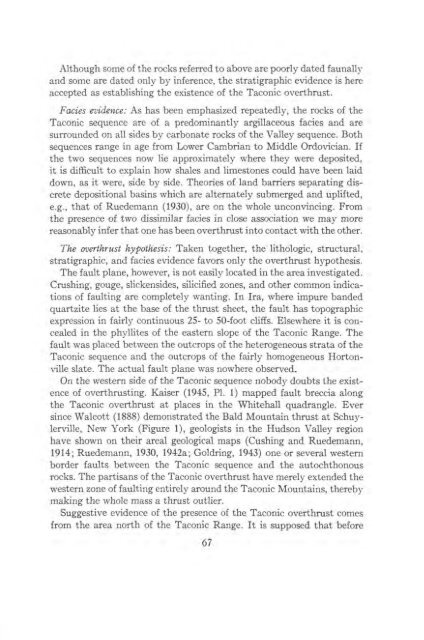STRATIGRAPHY AND STRUCTURE CASTLETON AREA VERMONT
STRATIGRAPHY AND STRUCTURE CASTLETON AREA VERMONT
STRATIGRAPHY AND STRUCTURE CASTLETON AREA VERMONT
You also want an ePaper? Increase the reach of your titles
YUMPU automatically turns print PDFs into web optimized ePapers that Google loves.
Although some of the rocks referred to above are poorly dated faunally<br />
and some are dated only by inference, the stratigraphic evidence is here<br />
accepted as establishing the existence of the Taconic overthrust.<br />
Facies evidence: As has been emphasized repeatedly, the rocks of the<br />
Taconic sequence are of a predominantly argillaceous facies and are<br />
surrounded on all sides by carbonate rocks of the Valley sequence. Both<br />
sequences range in age from Lower Cambrian to Middle Ordovician. If<br />
the two sequences now lie approximately where they were deposited,<br />
it is difficult to explain how shales and limestones could have been laid<br />
down, as it were, side by side. Theories of land barriers separating discrete<br />
depositional basins which are alternately submerged and uplifted,<br />
e.g., that of Ruedemann (1930), are on the whole unconvincing. From<br />
the presence of two dissimilar facies in close association we may more<br />
reasonably infer that one has been overthrust into contact with the other.<br />
The overthrust hypothesis: Taken together, the lithologic, structural,<br />
stratigraphic, and facies evidence favors only the overthrust hypothesis.<br />
The fault plane, however, is not easily located in the area investigated.<br />
Crushing, gouge, slickensides, silicified zones, and other common indications<br />
of faulting are completely wanting. In Ira, where impure banded<br />
quartzite lies at the base of the thrust sheet, the fault has topographic<br />
expression in fairly continuous 25- to 50-foot cliffs. Elsewhere it is concealed<br />
in the phyllites of the eastern slope of the Taconic Range. The<br />
fault was placed between the outcrops of the heterogeneous strata of the<br />
Taconic sequence and the outcrops of the fairly homogeneous Hortonyule<br />
slate. The actual fault plane was nowhere observed.<br />
On the western side of the Taconic sequence nobody doubts the existence<br />
of overthrusting. Kaiser (1945, P1. 1) mapped fault breccia along<br />
the Taconic overthrust at places in the Whitehall quadrangle. Ever<br />
since Walcott (1888) demonstrated the Bald Mountain thrust at Schuylerville,<br />
New York (Figure 1), geologists in the Hudson Valley region<br />
have shown on their areal geological maps (Cushing and Ruedemann,<br />
1914; Ruedemann, 1930, 1942a; Goldring, 1943) one or several western<br />
border faults between the Taconic sequence and the autochthonous<br />
rocks. The partisans of the Taconic overthrust have merely extended the<br />
western zone of faulting entirely around the Taconic Mountains, thereby<br />
making the whole mass a thrust outlier.<br />
Suggestive evidence of the presence of the Taconic overthrust comes<br />
from the area north of the Taconic Range. It is supposed that before<br />
67













